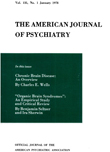The community meeting: a comparative study
Abstract
In this study of two identical open wards, the author found that in ward 1's highly structured meetings a higher proportion of patients participated, and they distributed their participation in more direct proportion to the relative numbers of each present than in the open meetings on ward 2, where patients directed their participation disproportionately to staff. Staff on both wards disproportionately directed their participation to patients, but less so in the structured meetings. The implications of these observations are discussed in terms of the executive ego deficits of the patients involved and their need for structure in the external milieu in order to compensate for these deficits.
Access content
To read the fulltext, please use one of the options below to sign in or purchase access.- Personal login
- Institutional Login
- Sign in via OpenAthens
- Register for access
-
Please login/register if you wish to pair your device and check access availability.
Not a subscriber?
PsychiatryOnline subscription options offer access to the DSM-5 library, books, journals, CME, and patient resources. This all-in-one virtual library provides psychiatrists and mental health professionals with key resources for diagnosis, treatment, research, and professional development.
Need more help? PsychiatryOnline Customer Service may be reached by emailing [email protected] or by calling 800-368-5777 (in the U.S.) or 703-907-7322 (outside the U.S.).



